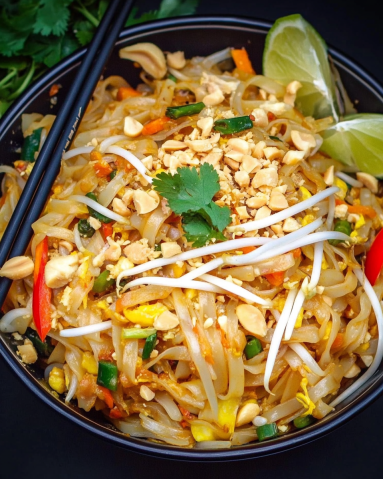Authentic Pad Thai Recipe
Authentic Pad Thai Recipe is both fun and rewarding.
But what truly makes Pad Thai authentic? It’s all about the balance of flavors and the quality of ingredients. The key components include rice noodles, a savory sauce, and fresh vegetables, often topped with crunchy peanuts and zesty lime. Each ingredient plays a vital role in creating that signature taste that Pad Thai is known for.
What Makes Pad Thai Authentic?
To understand the authenticity of Pad Thai, we must look at its roots. Originating in Thailand during the 1930s, this dish was influenced by Chinese stir-fry techniques. Authentic Pad Thai features rice noodles that are soaked to perfection, allowing them to absorb the flavors of the sauce. The sauce itself is a harmonious blend of fish sauce, tamarind paste, and sugar, which creates that irresistible sweet and tangy flavor.
Moreover, the use of fresh ingredients is crucial. Authentic recipes often include shrimp, tofu, or chicken, along with fresh bean sprouts and green onions. The addition of roasted peanuts not only adds crunch but also enhances the overall flavor profile. Finally, a squeeze of lime elevates the dish, making it refreshing and vibrant.
Authentic Pad Thai Recipe that captures the essence of this beloved dish. From gathering the right ingredients to mastering the cooking techniques, you’ll be well on your way to impressing your family and friends with your culinary skills!
Ingredients for Authentic Pad Thai Recipe
Authentic Pad Thai Recipe, you need to gather the right ingredients. Each component contributes to the overall flavor and texture of the dish. Here’s a list of what you’ll need:
- 8 ounces rice noodles: These are the base of your Pad Thai. Look for flat rice noodles for the best texture.
- 2 tablespoons vegetable oil: This will be used for stir-frying and adds a nice richness to the dish.
- 3 cloves garlic, minced: Garlic adds a wonderful aroma and flavor that enhances the overall dish.
- 1/2 pound shrimp, peeled and deveined: Shrimp is a popular protein choice, but you can substitute it with tofu for a vegetarian option.
- 2 large eggs, lightly beaten: Eggs add creaminess and help bind the ingredients together.
- 1 cup bean sprouts: These add crunch and freshness, making the dish more vibrant.
- 1/4 cup green onions, chopped: Green onions provide a mild onion flavor and a pop of color.
- 1/4 cup roasted peanuts, chopped: Peanuts add a delightful crunch and nutty flavor that complements the noodles.
- 1 lime, cut into wedges: Lime juice brightens the dish and adds a refreshing zing.
For the sauce, you will need:
- 3 tablespoons fish sauce: This is essential for that authentic umami flavor.
- 2 tablespoons tamarind paste: Tamarind gives the dish its signature tangy taste.
- 2 tablespoons brown sugar: This balances the flavors with a touch of sweetness.
- 1 tablespoon soy sauce: Soy sauce adds depth and saltiness to the dish.
- 1 teaspoon chili powder: Adjust this to your spice preference for a kick of heat.
With these ingredients in hand, you’re ready to embark on your culinary adventure. Each item plays a crucial role in achieving that authentic taste that makes Pad Thai so beloved. Let’s move on to the next step: preparing the noodles!
Step-by-Step Preparation of Authentic Pad Thai Recipe
Authentic Pad Thai Recipe is straightforward and enjoyable. Follow these steps to create a delicious dish that will impress everyone!
Step 1: Preparing the Noodles
Start by soaking the rice noodles in hot water. This should take about 30 minutes. You want them to be soft but not mushy. Once they are ready, drain the noodles and set them aside. This step is crucial as it ensures the noodles absorb the flavors of the sauce later on.
Step 2: Preparing the Sauce
Authentic Pad Thai Recipe, so make sure it’s well combined!
Step 3: Cooking the Protein
Next, heat the vegetable oil in a large skillet or wok over medium-high heat. Add the minced garlic and sauté for about 30 seconds until it becomes fragrant. Then, add the shrimp to the skillet. Cook for 2-3 minutes until the shrimp turns pink and is fully cooked. Once done, push the shrimp to one side of the skillet to make room for the eggs.
Step 4: Stir-Frying the Vegetables
Pour the beaten eggs into the empty side of the skillet. Scramble them until they are fully cooked. This adds a creamy texture to your dish. After the eggs are cooked, it’s time to add the soaked rice noodles and the prepared sauce. Toss everything together, ensuring the noodles are evenly coated and heated through. This should take about 2-3 minutes.
Step 5: Combining Ingredients
Authentic Pad Thai Recipe.
Step 6: Garnishing the Dish
Authentic Pad Thai Recipe hot and fresh!
Variations of Authentic Pad Thai Recipe

Authentic Pad Thai Recipe is delicious as is, there are many ways to customize it to suit different dietary preferences and tastes. Here are some popular variations that you can try!
Vegetarian Options
If you’re looking for a vegetarian version of Pad Thai, you can easily swap out the shrimp for tofu. Tofu is a fantastic protein source and absorbs flavors beautifully. Here’s how to make a vegetarian Pad Thai:
- Use firm tofu: Cut it into cubes and pan-fry until golden brown. This adds a nice texture.
- Include more vegetables: Add bell peppers, carrots, or broccoli for extra nutrition and color.
- Replace fish sauce: Use soy sauce or a vegetarian fish sauce alternative to maintain that umami flavor.
This vegetarian Pad Thai is just as satisfying and packed with flavor, making it a great option for those who prefer plant-based meals.
Gluten-Free Alternatives
For those who are gluten-sensitive or have celiac disease, making a gluten-free Pad Thai is simple. Here are some tips:
- Choose gluten-free noodles: Look for rice noodles that are labeled gluten-free. Most rice noodles are naturally gluten-free, but it’s always good to check.
- Use tamari instead of soy sauce: Tamari is a gluten-free soy sauce alternative that works perfectly in the sauce.
- Check your fish sauce: Most fish sauces are gluten-free, but it’s wise to read the label to ensure there are no hidden gluten ingredients.
Authentic Pad Thai Recipe that everyone can savor!
These variations not only cater to different dietary needs but also allow you to explore new flavors and textures. Feel free to get creative and make the dish your own!
Cooking Note for Authentic Pad Thai Recipe
Authentic Pad Thai Recipe, there are a few cooking notes to keep in mind. These tips will help you achieve the best results and ensure your dish is as delicious as possible.
First, always use fresh ingredients. Fresh vegetables and proteins will enhance the flavor and texture of your Pad Thai. If you can, buy your ingredients from local markets or trusted grocery stores.
Next, pay attention to the heat level. Cooking on medium-high heat is essential for stir-frying. This allows the ingredients to cook quickly while retaining their freshness. If the heat is too low, the noodles may become soggy, and the shrimp may not cook properly.
Additionally, don’t be afraid to adjust the sauce to your taste. If you prefer a sweeter Pad Thai, add a bit more brown sugar. For a spicier kick, increase the chili powder. Taste as you go to find the perfect balance for your palate.
Lastly, serve your Pad Thai immediately after cooking. This dish is best enjoyed hot and fresh. The longer it sits, the more the noodles will absorb the sauce, which can lead to a less desirable texture.
Authentic Pad Thai Recipe that everyone will love!
Serving Suggestions for Authentic Pad Thai Recipe
Authentic Pad Thai Recipe can be just as important as cooking it. Presentation can elevate the dining experience and make your dish even more appealing. Here are some serving suggestions to consider:
- Garnish generously: Use chopped roasted peanuts, fresh cilantro, and lime wedges to add color and flavor. These toppings not only enhance the dish but also provide a delightful crunch.
- Pair with sides: Serve your Pad Thai with a side of fresh spring rolls or a light salad. This adds variety to the meal and complements the flavors of the noodles.
- Offer condiments: Provide extra chili flakes, lime juice, or soy sauce on the side. This allows guests to customize their dish to their liking.
- Use colorful plates: Presenting your Pad Thai on vibrant plates can make the dish pop visually. A colorful presentation can make the meal feel more festive and inviting.
Authentic Pad Thai Recipe will not only taste amazing but also look stunning on the table. Enjoy sharing this delightful dish with family and friends!
Cooking Note for Authentic Pad Thai Recipe
Authentic Pad Thai Recipe, there are a few cooking notes to keep in mind. These tips will help you achieve the best results and ensure your dish is as delicious as possible.
First, always use fresh ingredients. Fresh vegetables and proteins will enhance the flavor and texture of your Pad Thai. If you can, buy your ingredients from local markets or trusted grocery stores. Freshness is key to making your dish vibrant and tasty.
Next, pay attention to the heat level. Cooking on medium-high heat is essential for stir-frying. This allows the ingredients to cook quickly while retaining their freshness. If the heat is too low, the noodles may become soggy, and the shrimp may not cook properly. A hot skillet ensures that everything cooks evenly and quickly.
Additionally, don’t be afraid to adjust the sauce to your taste. If you prefer a sweeter Pad Thai, add a bit more brown sugar. For a spicier kick, increase the chili powder. Taste as you go to find the perfect balance for your palate. Remember, cooking is all about personal preference!
Lastly, serve your Pad Thai immediately after cooking. This dish is best enjoyed hot and fresh. The longer it sits, the more the noodles will absorb the sauce, which can lead to a less desirable texture. Enjoying it right away ensures that every bite is flavorful and satisfying.
Authentic Pad Thai Recipe that everyone will love!
Serving Suggestions for Authentic Pad Thai Recipe
Authentic Pad Thai Recipe can be just as important as cooking it. Presentation can elevate the dining experience and make your dish even more appealing. Here are some serving suggestions to consider:
- Garnish generously: Use chopped roasted peanuts, fresh cilantro, and lime wedges to add color and flavor. These toppings not only enhance the dish but also provide a delightful crunch.
- Pair with sides: Serve your Pad Thai with a side of fresh spring rolls or a light salad. This adds variety to the meal and complements the flavors of the noodles.
- Offer condiments: Provide extra chili flakes, lime juice, or soy sauce on the side. This allows guests to customize their dish to their liking.
- Use colorful plates: Presenting your Pad Thai on vibrant plates can make the dish pop visually. A colorful presentation can make the meal feel more festive and inviting.
Authentic Pad Thai Recipe will not only taste amazing but also look stunning on the table. Enjoy sharing this delightful dish with family and friends!
Tips for Perfecting Your Authentic Pad Thai Recipe
Authentic Pad Thai Recipe is an art that combines technique, timing, and a touch of creativity. Here are some valuable tips to help you master this beloved dish and impress your family and friends!
First, always soak your rice noodles properly. The noodles should be soft but not mushy. If they are over-soaked, they can become sticky and clump together. Keep an eye on them while soaking, and drain them as soon as they reach the right texture.
Next, use high-quality ingredients. Fresh shrimp, vibrant vegetables, and authentic sauces will elevate your Pad Thai. Look for fish sauce and tamarind paste that are made from natural ingredients. This will enhance the overall flavor of your dish.
When cooking, keep your ingredients organized. Prepare everything in advance, so you can add them quickly to the skillet. This is crucial for stir-frying, as it allows you to maintain the right cooking temperature and ensures even cooking.
Don’t overcrowd the skillet. If you’re making a large batch, consider cooking in smaller portions. Overcrowding can lower the heat and lead to steaming instead of stir-frying, which can affect the texture of your noodles and vegetables.
Adjust the seasoning to your taste. Everyone has different preferences, so feel free to tweak the sauce ingredients. If you like it sweeter, add more brown sugar. For a spicier kick, increase the chili powder. Taste as you go to find your perfect balance.
Lastly, serve your Pad Thai immediately after cooking. This dish is best enjoyed hot and fresh. The longer it sits, the more the noodles will absorb the sauce, which can lead to a less desirable texture. Enjoying it right away ensures that every bite is flavorful and satisfying.
Authentic Pad Thai Recipe. Happy cooking!
Breakdown of Time for Authentic Pad Thai Recipe
Authentic Pad Thai Recipe can help you plan your cooking session better. Here’s a breakdown of the time you’ll need for preparation and cooking.
Prep Time
Authentic Pad Thai Recipe is approximately 30 minutes. This includes soaking the rice noodles and preparing the sauce. While the noodles soak, you can chop the vegetables, mince the garlic, and measure out the sauce ingredients. This multitasking will save you time and keep everything organized.
Cooking Time
Once you have everything prepped, the cooking time is about 10-15 minutes. This includes sautéing the garlic, cooking the shrimp, scrambling the eggs, and stir-frying the noodles with the sauce and vegetables. The quick cooking process is essential to maintain the freshness and texture of the ingredients.
Total Time
Authentic Pad Thai Recipe in no time!
Nutritional Information for Authentic Pad Thai Recipe
Authentic Pad Thai Recipe can help you make informed choices about your meals. This dish is not only delicious but also provides a good balance of nutrients. Here’s a breakdown of the key nutritional information per serving:
Calories
Each serving of this delightful Pad Thai contains approximately 380 calories. This makes it a satisfying meal that can fit into a balanced diet. The calorie count comes from the combination of rice noodles, shrimp, eggs, and the flavorful sauce. Enjoying this dish in moderation can be part of a healthy eating plan.
Protein
Protein is essential for building and repairing tissues, and each serving of Pad Thai provides about 20 grams of protein. The shrimp and eggs are excellent sources of high-quality protein, making this dish a great option for those looking to increase their protein intake. If you opt for tofu in your vegetarian version, you’ll still get a good amount of protein while enjoying the same delicious flavors.
Sodium
One serving of Pad Thai contains around 800 milligrams of sodium. This is primarily due to the fish sauce and soy sauce used in the recipe. While sodium is necessary for bodily functions, it’s important to monitor your intake. If you’re watching your sodium levels, consider using low-sodium soy sauce or fish sauce alternatives to reduce the overall sodium content without sacrificing flavor.
Advertisement
Authentic Pad Thai Recipe while being aware of its health benefits. This dish is not only a treat for your taste buds but also a source of essential nutrients!
FAQs about Authentic Pad Thai Recipe
What is the origin of Pad Thai?
Pad Thai has a rich history that dates back to the 1930s in Thailand. It was created during a time when the Thai government wanted to promote national identity and reduce rice consumption. The dish combines Chinese stir-fry techniques with local ingredients, making it a unique blend of cultures. Today, Pad Thai is a beloved street food and a staple in Thai cuisine, enjoyed by people all over the world.
Can I make Pad Thai ahead of time?
While Pad Thai is best enjoyed fresh, you can prepare some components ahead of time. For instance, you can soak the rice noodles and prepare the sauce in advance. However, it’s recommended to cook the dish just before serving to maintain the texture of the noodles and the freshness of the ingredients. If you do have leftovers, store them in an airtight container in the refrigerator and reheat gently on the stove.
What can I substitute for tamarind paste?
Authentic Pad Thai Recipe.
Is Pad Thai healthy?
Pad Thai can be a healthy meal option, especially when made with fresh ingredients. It provides a good balance of carbohydrates, protein, and healthy fats. The dish is rich in vitamins and minerals from the vegetables and can be customized to suit your dietary needs. For a healthier version, consider using less oil, adding more vegetables, or opting for a lean protein source like tofu or shrimp. Enjoying Pad Thai in moderation can be part of a balanced diet!
Conclusion on Authentic Pad Thai Recipe
Authentic Pad Thai Recipe is a rewarding culinary adventure that brings the vibrant flavors of Thailand into your home. This dish, with its perfect balance of sweet, sour, and savory notes, is not only delicious but also versatile. Whether you choose to stick to the traditional shrimp version or explore vegetarian and gluten-free alternatives, Pad Thai can cater to various dietary preferences.
By following the steps outlined in this article, you can create a dish that is both satisfying and impressive. Remember to use fresh ingredients, pay attention to cooking techniques, and adjust the flavors to suit your taste. With practice, you’ll master the art of stir-frying and become confident in your ability to whip up this beloved Thai classic.
As you serve your homemade Pad Thai, don’t forget to garnish generously and present it beautifully. Sharing this dish with family and friends will surely create memorable moments around the dining table. So, gather your ingredients, roll up your sleeves, and embark on this delicious journey to Thailand right from your kitchen!
Authentic Pad Thai Recipe!






